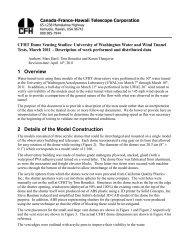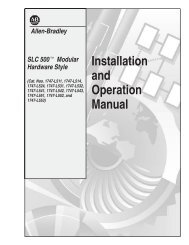Documentation [PDF] - Canada France Hawaii Telescope ...
Documentation [PDF] - Canada France Hawaii Telescope ...
Documentation [PDF] - Canada France Hawaii Telescope ...
You also want an ePaper? Increase the reach of your titles
YUMPU automatically turns print PDFs into web optimized ePapers that Google loves.
· 0/32 : masked in r band<br />
· 0/64 : masked in g band<br />
· 0/128 : masked in u band<br />
For exemple, an object with flag 37 is a star which is in a masked region in the r and z<br />
bands.<br />
∗ u ∗ ,g,r,i/y,z : Depending on the catalog, object MAG_AUTO or MAG_SNLS magnitudes<br />
in the MegaCam instrumental reference frame. When magnitude and its error are missing,<br />
these values are set to 99. Note that the i or y magnitudes are both listed in a column<br />
labelled i on the top header of each catalog.<br />
∗ u ∗ err,g err ,r err ,(i/y) err ,z err : Object magnitude errors;<br />
∗ e(b-v): the values of the galactic extinction are calculated using the Schlegel et al.<br />
(1998) dust map at the object’s position. The extinction, E(B − V), is derived at each<br />
source position using a linearly interpolated dust value from the four nearest pixels. The<br />
E(B − V) is then added in the last column of the merged catalogue;<br />
∗ u ∗ SEx−flag , g SEx−flag, r SEx−flag , (i/y) SEx−flag , z SEx−flag : SExtractor extraction flags,<br />
for each filter. Each flag is set to zero when no source extraction problem is encountered,<br />
or follows the sum of power-of-two rule 26 ;<br />
∗ dk : object cell number for the spatially variable color-term (see photometric calibration).<br />
∗ u_IQ20,g_IQ20,r_IQ20,i/y_IQ20,z_IQ20 (only in the SNLS catalogues). IQ20<br />
magnitudes are MAG_SNLS aperture magnitudes corrected by an aperture correction factor<br />
to estimate the flux in an aperture of 20 ∗ FWHM. This magnitude is a better measurement<br />
for stellar total flux.<br />
– The Deep merged catalogues also contain the parameters extracted from the chi2-RSC, but<br />
for six filters instead of five, as for the Wide. All catalogues have ugriyz data for all sources.<br />
342 Wide merged catalogues are produced, one per tile, two for MAG_AUTO, MAG_SNLS, and 32<br />
Deep merged catalogues are produced, two per field (D-25 and D-85), two for MEDIAN/SIGWEI,<br />
two for MAG_AUTO, MAG_SNLS;<br />
• the ASCII multi-aperture merged source catalogues (MAM-SC), produced like the (M-SC), but<br />
the catalogues only include the data from the 27 apertures (SNLS+26 apertures) and aperture<br />
magnitudes of each sources of the chi2-RSC catalogue. The aperture sizes range from 10 to 60<br />
pixels. As the M-SC, 171 Wide catalogues and 16 Deep catalogues are produced. These catalogues<br />
are very large (1-3 GB). They have 536 columns per source for the Wide and 642 for the Deep.<br />
• The ASCII Wide patch merged catalog (WPM-SC). These four catalogues (one for each Wide<br />
patch) contain all parameters in all filters for each object detected in the corresponding Wide<br />
patch. The parent catalogues are the Chi2 catalogues (27 apertures) which are merged together.<br />
All catalogues have a header on that describes the meaning of each column.<br />
All data of the two last catalogues with the exception of the E(B − V) for the merged source catalogue,<br />
are extracted from the large chi2-RSCs. They are produced only for convenience. All of them have been<br />
produced using SExtractor, but with different configuration files and output parameter lists. Most i<br />
stacks are made with the first i-(i.MP9702) filter. However, there are 16 W1, 2 W2, 7 W3 and 7 W4<br />
26 http://astromatic.iap.fr/software/sextractor<br />
93


![Documentation [PDF] - Canada France Hawaii Telescope ...](https://img.yumpu.com/26965302/105/500x640/documentation-pdf-canada-france-hawaii-telescope-.jpg)









